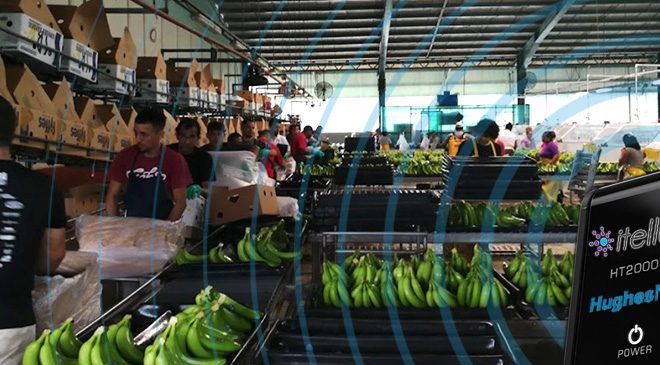ITellum – Satellite Service in Limón
A region that sets itself apart from the rest of #Costa Rica is on the Caribbean coast in the urban area of #Limón in the province of the same name. #PuertoLimón is experiencing recent growth and gives the country access to commerce with countries in the east. It is a key location for High-speed Satellite Broadband Internet offered by Itellum. As an instrumental element to international exports and imports that have fueled the economy for decades, not only for the surrounding general area but for the entire country, Limón has not always received the attention it deserves. However, Secure and Fast Satellite Services give the area and it’s much-needed essential services a solid base.
Today Limón has a population of approximately 70,000 people. Isla Uvita, an island just off the coast of #PuertoLimón, marks the colonization of the area dating back to 1502 when Christopher Columbus landed there for the first time. His welcoming committee were native people who adorned with an abundance of gold jewelry and this lead to a belief that many riches could be found in the area. The country’s name, “Rich Coast” or #Costa Rica may well have come from this association. To finance the conquest of the area in 1569, large sections of land and their indigenous habitants in #Matina were awarded to aristocrats. This was an effort to exploit the local Indians, but the deceptive plan did not materialize because the majority of native people were not desperate enough to take the bait. Back then, the absentee landowners from the capital city of #Cartago (at the time) needed a source of revenue. To facilitate this, they imported African slaves to work the land. In 1666, famous “pirate” Henry Morgan landed in a small bay known as Portete between Moín and Limón. When he and his crew tried to venture inland toward #Cartago, they were met with opposition and went back to their ship, never to return. Fast forward to 1854 when #Limón was officially founded and later in 1867 when railroad construction began connecting the Costa Rica highlands to the sea. Limón became the major port to expedite coffee exports from the central valley to the international market. This infrastructure also aided in the lucrative cultivation and exportation of bananas.
Hired workers came from Jamaica, Barbados, and Trinidad and Tobago towards the end of the 19th century. Prior to that, African slaves mixed with indigenous people of the region and that fashioned the ethnic and cultural base of the area. This is why the majority of the population speaks English with a Jamaican accent and also why many have English surnames. These factors also give Limon a unique ambiance that differentiates it from the rest of the country and blends with the Caribbean flavor and turquoise waters that form its coast.
Historically the government has not invested a lot in improvements, infrastructure, and general enhancements over the years. Although always appreciated for its natural beauty, the perception of the area is changing with the availability of Costa Rica’s only High-Speed Satellite Internet. In 1991 a severe earthquake devastated commerce and presented a huge setback to the area. Many roads and bridges were destroyed cutting off the area from the central valley and the aid that was much needed. Although it has taken a long time to rebuild, the Caribbean coast attracts many tourists from Europe and the tourism sector continues to grow and diversify. The city of Limon and the towns along the coast have been affected positively from the increase in business related to tourism as well as shipping and import/export activity. Rural Satellite Internet brings the necessary communication networks to these areas as well as inland rural communities.
Limón province has two ports, Limón and Moín. Reliable Satellite Internet and Broadband is clearly essential to the operations of all related industry. Recope, or the Costa Rican Petroleum Refinery, opened a wharf for the importation of crude oil and petroleum products in 1981. Since then the wharf has expedited movement of banana trees, orange juice, fertilizers, and fuels. The container terminal which was also opened in 1981 experienced expansion over the years to 12.5 hectares but has seen little improvement until now. Plans to spend on infrastructure, housing, schools, roads, security, and culture will amount to approximately $1 billion over the next ten years. The decision to invest here stems from the new $1.1 billion container terminal that was inaugurated February 2019 and the forecasted developmental impact it is predicted to have. The MCT or Moin Container Terminal is the largest public infrastructure project in Costa Rica’s history. Itellum’s foresight to bring Fast Satellite Internet is a great asset to the operations of this mega-project!
APM Terminals, a division of Maersk, is the corporation charged with the construction and operations of the new container terminal. The outlook is that the new port facility will impact the area positively, including the entire country because it can accept ships four times larger than previously. This translates to an increase of $2.9 billion in GDP by increasing the countries trade capabilities by 23% while creating about 145,000 new jobs nationally. The projection of the creation of 550 new jobs and 1,100 related jobs will give a boost to the economy of the Limon area alone. A percentage of the net income generated from MCTs operations will fuel investment of $1.1 billion in the area infrastructure. This injection of funds is expected to attract foreign investment and has already attracted large corporations. Itellum investment in providing the Best Satellite Broadband possible offers areas with little, poor, and no #Internet service, and will now provide download speeds of up to 25/1 Mbps. This is achieved through HughesNet Satelite called Jupiter 2. This vast improvement in the area will make way for more opportunities for the residents with increased labor force requirements, skills development, training facilities, incentives for renewable energies, and conservation of wildlife.
Raw nature and wildlife adorn the Caribbean coast and now there are more opportunities than there were in the past. Tourists, mostly European, investors, and business entrepreneurs are attracted by the uniqueness and intrigue of the Caribbean coast. The areas natural beauty is spectacular and complimented by an intense diversity of flora and fauna with over 300 square kilometers (116) square miles) of pristine beaches, primarily undeveloped. Representing only 9% of Costa Rica’s population, the province of Limón is 9,200 square kilometers (3,500 square miles).
Although the population is very low density, these remote areas are used as both their lifestyle, income and in some cases, their transportation. The region and national park of #Tortuguero is one of those rural areas and is considered one of the most frequently visited national treasures. Translated loosely, it means “turtle nesting ground” and is a network of canals with beaches that stretch approximately 22 miles. Some of the types of turtles that breed in this protected area are green, leatherback, hawksbill, and loggerhead. The diversity of eleven unique coastal environments attracts a variety of animals. Three species of monkeys, more than 300 bird species, crocodiles, caimans, jaguars, manatees, tapirs, jaguars, sloths, river otters, and poison dart frogs all have a presence here.
The beauty of this is that it feeds the tour companies by attracting travelers to the biodiversity of the area and in turn contributes to the economy. Internet via satellite allows for improved communications and logistics making the tourist industry and related businesses more efficient.
Another element that sets Limón, with its rich history and surroundings, apart from the rest of Costa Rica the fall festival known as Limón Carnival that starts with the “Día de Las Culturas” starting on October 12th and continues for approximately 10 to 12 days. This is a major attraction locally and internationally that celebrates the cornucopia of cultures that encompasses all things Caribbean. Reggae, Calypso, other Caribbean-style music, and dancing in the street, parades, typical foods, concerts, and colors are what this high-energy street festival is all about. The cuisine is unique and captures the tastebuds of many people with traditional dishes like jerk chicken, rice and beans, rondón and pan bon served to an eager audience in an ambiance distinctively “del Caribe”. At times one might think they have traveled to another country with the variety of languages ranging from Spanish to Creole English to an array of other European and Asian languages that permeate all the festivities. In recent years the weather, which is normally perfect in October, has not cooperated with the Limón Carnival. However with the aid of Itellum’s Satellite Internet in Costa Rica, “Carnival” maintains it’s popularity and attraction.
Limón is a captivating area, however, it can represent a tiring, yet extremely scenic drive to get there. There was a “jungle train” that went years ago that was greatly damaged by the earthquake of 1991. This was a preferred mode of transportation for many people. Although the resurrection of the train would recreate a popular experience, it is more likely that the Limón International Airport would be upgraded as development expands in the area. This would open up transportation for tourist and business traffic since the airport traditionally facilitated private or charter flights. When the airport is improved it will be able to take advantage of its international designation and serve as a hub for the east coast as well as providing access to countries in the Caribbean and South America. It only makes sense that the number one rated satellite broadband will be instrumental in helping this region to flourish.
So you don´t have to wait more. You can to contact us by Whatsapp or using this form.






